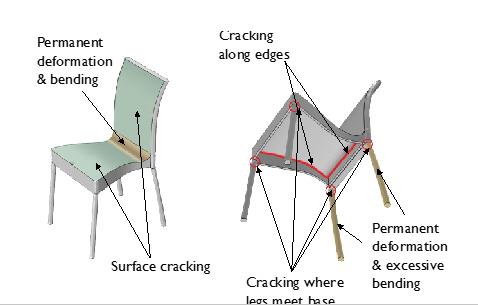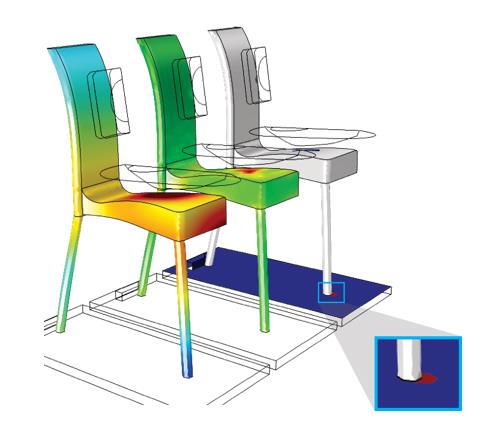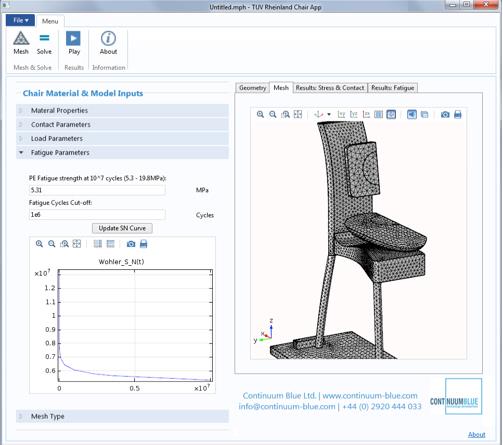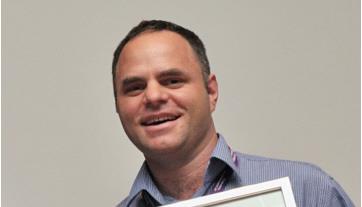Behind every consumer product that hits the market is an iterative process of designing, redesigning, prototyping, and testing that points to the work of researchers, engineers, and specialists ensuring that an object is ready for retail. To meet requirements for safety and quality, manufacturers must pass an assessment to verify that their product can be sold in stores.
For a chair to be allowed on the shelves, this rigorous process involves confirming that it will hold a person’s weight, retain its shape, and not buckle under certain conditions. A chair must survive thousands of cycles of repeated loading over a lifetime and cannot suffer cracking, breaking, or bowing.
Test houses lighten the load for designers
Because this testing process can be costly and time consuming for clients needing certification, an independent assessment organisation (a “test house”) is striving to lessen the burden on companies involved in chair production. They test hundreds of different chairs every year, and each design that fails to meet the European and American quality standards (EN, BS, ISO, and ANSI standards) results in disappointment for chair producers and thousands of dollars in design changes and re-testing.
To reduce the burden on manufacturers, a test house turned to Continuum Blue, a COMSOL Certified Consultant helping companies develop numerical simulation apps, to create a tool the test house could offer clients for testing different chairs. This would allow them to virtually predict whether a chair design would pass or fail prior to the physical testing stage.
“Our customer wanted to explore whether they could develop simulation applications for their test services,” explained Dr Mark Yeoman, director of Continuum Blue. “Their clients would be able to log in remotely, upload various chair designs, and virtually test each one. Only once they were confident that a chair passed the virtual test would they manufacture the design and send a sample to the test house.”
Such a test app would require a diverse range of functionality. It would have to incorporate the quality criteria, be intuitive and usable for engineers and designers at all stages of the development process, and be flexible enough to test different chair models, shapes, and materials.
Simulation paves the way to quicker furniture assessment
Yeoman developed a numerical model using COMSOL Multiphysics software that would predict a chair’s response to a standard loading test. His simulation included the chair geometry, floor, blocks to hold the legs in place, and loading plates for the back and base to mimic the physical test (see Figure 1).
Ultimately, the question the simulation needed to answer for many different designs was, “will this chair fail under the required load?”

Figure 1 Setup of the chair test. Overlaid, geometry of the Continuum Blue chair model.

Figure 2 Schematic showing crucial points in the chair where failure typically occurs.
“A chair has to hold up to scrutiny in quite a few areas,” Yeoman remarked. “It must survive a lifetime without breaking, endure continued use with no cracking, and the legs should not bend, splay apart, or bow too much. If cracking occurs in the corners where the legs meet the base, the chair will fail.”
Measuring up to the testing criteria
“The first part of the test is a Static Load Test to see if the chair can hold a certain maximum load,” Yeoman explained. “The test loads the chair over a 20-second period, initially loading the base and then the back, to mimic a large person sitting down and then leaning back. The second part involves a fatigue evaluation, where the chair is repeatedly loaded and unloaded over thousands of cycles. This is equivalent to the chair being used over many years.”
Yeoman’s model analysed the deformation during a person sitting down, the mechanical stress, and the earliest and likeliest points of failure (see Figure 2). The model also assessed the contact pressure between the chair, loading plates, and floor, and predicted number of cycles to failure (see Figure 3).
“Setting up most of the model was straightforward,” he added. “The structural mechanics, material properties, and load parameters were relatively quick to implement in COMSOL software.” Many mechanical factors influence the pass or failure of a chair test, but the contact study was the tricky part, as Yeoman explained: “Contact analysis is inherently complex; it is highly dependent on the material properties of the contact surfaces, the coefficients of friction, and is highly nonlinear in nature.

Figure 3 Simulation showing deformation (left), stress (centre), and contact pressure (right) for a single chair during loading.

Figure 4 The Continuum Blue app showing mesh and input fields for a client to adjust according to their design needs.
“There are several points of contact that make this an inherently unstable contact problem: four points of contact between the chair legs and the floor, then points between the seat and the bottom loading plate, and the chair back and the back-loading plate,” he continued. “We use the material stiffness, yield stress, and coefficient of friction to help us accurately define the contact parameters.”
Making virtual testing quick and easy
After completing and validating the COMSOL model, the Continuum Blue team went on to build the customised user interface, or application, that would allow a user to quickly run virtual tests on chair designs by changing certain inputs and parameters related to geometry, load conditions, and material properties.
“We used the Application Builder in COMSOL Multiphysics,” Yeoman commented. The Application Builder allows the app designer to arrange entry fields, results tables, buttons, drop-down options, and graphics. The resulting app runs the full simulation, but the user — who may have no background in engineering or multiphysics modelling — has access to only the chosen inputs, not the model, physics, or analysis underneath.
“For the test application we built for our client, we wanted the user to be able to define various options, like nonlinear materials. We parameterised all the model features so that they were fully linked, and when someone changed one parameter the simulation would update accordingly.”
“When the chair is loaded, stress levels are assessed against the yield and tensile strength of the material. If it goes into permanent plastic deformation, the relevant regions of the chair will be highlighted to let the user know that the chair is yielding. If the stress rises above the tensile strength of the material, then the chair has some form of catastrophic material failure, such as cracking and fracturing,” Yeoman said. “The app will automatically show a pop-up window announcing that stress levels have gone above the material tensile strength and the chair has failed.”

Mark Yeoman, director at Continuum Blue.
This was exactly what the test house had been looking for, an application that allows chair manufacturers and designers to import their own chair geometry, select materials, define contact and loading conditions, and check the results against the test requirements to immediately see whether the design would pass or fail (see Figure 4).
Through a local installation of the COMSOL Server product, Yeoman was also able to distribute the app to different users, allowing them to log in to a database and launch specific apps. The test house, in turn, intends to use COMSOL Server in the future for sharing test apps with their own clients all over the world.
“These apps will make it much simpler for designers and test engineers to easily assess a chair’s performance before production and physical testing,” Yeoman said. “This will give them the ability to virtually assess dozens of designs before deciding on a single successful design to prototype and test, knowing with confidence that it will meet the test requirements of the quality standards, reducing the time and cost spent on building and testing physical prototypes.”